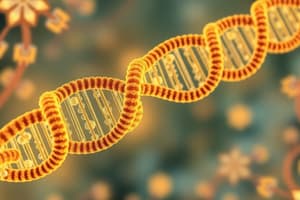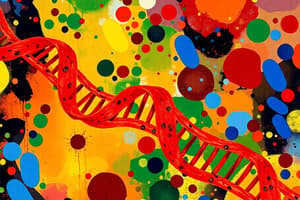Podcast
Questions and Answers
What is the role of the template strand of DNA during transcription?
What is the role of the template strand of DNA during transcription?
- It binds directly to the RNA polymerase.
- It serves as the coding strand for protein synthesis.
- It is transcribed into RNA as a complementary sequence. (correct)
- It initiates the transcription process.
How does the primary transcript differ in bacteria compared to eukaryotes?
How does the primary transcript differ in bacteria compared to eukaryotes?
- The 5' end of the primary transcript is the same as the mature mRNA in bacteria. (correct)
- It is processed to include a 7-methylguanosine cap in bacteria.
- It undergoes extensive modifications in bacteria.
- Bacterial primary transcripts contain more than one gene.
What is the significance of the sigma factor in bacterial RNA polymerase?
What is the significance of the sigma factor in bacterial RNA polymerase?
- It assists in the elongation of the RNA chain.
- It increases the affinity of RNA polymerase for non-promoter DNA.
- It synthesizes RNA independently of a DNA template.
- It plays a key role in promoter recognition. (correct)
Which RNA polymerase is responsible for synthesizing mRNA in eukaryotic cells?
Which RNA polymerase is responsible for synthesizing mRNA in eukaryotic cells?
What occurs at the transcription start site (TSS) during transcription?
What occurs at the transcription start site (TSS) during transcription?
What is a primary function of the 7-methylguanosine cap added to eukaryotic mRNA?
What is a primary function of the 7-methylguanosine cap added to eukaryotic mRNA?
In the context of transcription, what does the term 'transcription unit' refer to?
In the context of transcription, what does the term 'transcription unit' refer to?
Which part of the DNA is characterized as upstream and what does it imply?
Which part of the DNA is characterized as upstream and what does it imply?
Which of the following steps is not part of the RNA synthesis process?
Which of the following steps is not part of the RNA synthesis process?
What type of RNA is directly involved in encoding proteins?
What type of RNA is directly involved in encoding proteins?
What is a major consequence of errors in mRNA synthesis and processing?
What is a major consequence of errors in mRNA synthesis and processing?
Which of the following accurately describes a function of tRNA?
Which of the following accurately describes a function of tRNA?
Which characteristic of RNA synthesis distinguishes it from DNA synthesis?
Which characteristic of RNA synthesis distinguishes it from DNA synthesis?
Which RNA class plays a significant role in gene regulation?
Which RNA class plays a significant role in gene regulation?
What is the primary function of rRNA?
What is the primary function of rRNA?
Which statement about ribonucleotides in RNA is true compared to deoxyribonucleotides in DNA?
Which statement about ribonucleotides in RNA is true compared to deoxyribonucleotides in DNA?
Flashcards
RNA synthesis
RNA synthesis
The process of creating an RNA molecule using a DNA template.
RNA polymerase
RNA polymerase
The enzyme that synthesizes RNA from a DNA template.
mRNA (messenger RNA)
mRNA (messenger RNA)
RNA that carries genetic information to ribosomes for protein synthesis.
ncRNA (non-protein coding RNA)
ncRNA (non-protein coding RNA)
Signup and view all the flashcards
rRNA (ribosomal RNA)
rRNA (ribosomal RNA)
Signup and view all the flashcards
tRNA (transfer RNA)
tRNA (transfer RNA)
Signup and view all the flashcards
Transcription
Transcription
Signup and view all the flashcards
RNA synthesis steps
RNA synthesis steps
Signup and view all the flashcards
DNA vs. RNA synthesis difference 1
DNA vs. RNA synthesis difference 1
Signup and view all the flashcards
DNA vs. RNA synthesis difference 2
DNA vs. RNA synthesis difference 2
Signup and view all the flashcards
DNA vs. RNA synthesis difference 3
DNA vs. RNA synthesis difference 3
Signup and view all the flashcards
DNA vs. RNA synthesis difference 4
DNA vs. RNA synthesis difference 4
Signup and view all the flashcards
DNA vs. RNA synthesis difference 5
DNA vs. RNA synthesis difference 5
Signup and view all the flashcards
Template Strand of DNA
Template Strand of DNA
Signup and view all the flashcards
Non-template Strand
Non-template Strand
Signup and view all the flashcards
RNA Polymerase (RNAP)
RNA Polymerase (RNAP)
Signup and view all the flashcards
Promoter
Promoter
Signup and view all the flashcards
Transcription Start Site (TSS)
Transcription Start Site (TSS)
Signup and view all the flashcards
Transcription Unit
Transcription Unit
Signup and view all the flashcards
Primary Transcript
Primary Transcript
Signup and view all the flashcards
7-methylguanosine Cap
7-methylguanosine Cap
Signup and view all the flashcards
Core Enzyme
Core Enzyme
Signup and view all the flashcards
Sigma Factor
Sigma Factor
Signup and view all the flashcards
Eukaryotic RNA Polymerase II
Eukaryotic RNA Polymerase II
Signup and view all the flashcards
Study Notes
RNA Synthesis, Processing, and Modification
- RNA synthesis is a complex process using DNA-dependent RNA polymerase enzymes and additional proteins.
- General steps involve initiation, elongation, and termination.
- RNA must be processed to become mature and active.
- mRNA synthesis and metabolism are crucial for adaptation to environmental changes and maintaining cell structure and function.
- Errors in synthesis, processing, splicing, stability, or mRNA function can cause diseases.
RNA Classes
- Two major types of RNA exist in eukaryotic cells:
- Messenger RNA (mRNA): Protein-coding, usually unstable or moderately stable.
- Non-protein coding RNA (ncRNA): Includes rRNA, lncRNA, tRNA, and miRNA, involved in regulation or protein synthesis.
- mRNA directly encodes proteins.
- rRNA is part of the ribosome for translation.
- tRNA transfers amino acids to ribosomes.
- lncRNA and miRNA are involved in gene regulation, either by influencing mRNA stability or modulating transcription.
RNA Synthesis from a DNA Template
- RNA synthesis is similar to DNA synthesis, using initiation, elongation, and termination with 5'→3' polarity, multicomponent complexes, and Watson-Crick base pairing.
- Differences include:
- Ribonucleotides are used instead of deoxyribonucleotides.
- Uracil (U) replaces thymine (T).
- RNA polymerases can initiate synthesis without a primer.
- RNA synthesis transcribes specific genome portions.
- RNA polymerases have less proofreading, leading to higher mutation rates.
Transcription
- The template strand of DNA is transcribed into RNA, read in 3'→5' direction.
- The non-template strand corresponds to the mRNA sequence (except T→U).
- RNA polymerase binds to the promoter, a specific DNA region, to begin transcription.
- Transcription starts at the transcription start site (TSS).
- A transcription unit includes initiation, elongation, and termination signals, often a single gene in eukaryotes, but multiple in prokaryotes.
- The primary transcript is the initial RNA product.
Bacterial RNA Polymerase
- Bacterial RNA polymerase (RNAP) has a core enzyme (ββ′α2ω) for RNA synthesis and a sigma (σ) factor for promoter binding.
- The sigma factor is crucial for promoter recognition; it reduces non-promoter affinity and increases promoter affinity.
- Multiple sigma factors exist; each recognizes different promoters, leading to the expression of different genes and regulating gene expression in response to environmental changes (e.g., sporulation, nutrient deprivation, heat shock).
Eukaryotic RNA Polymerases
- Mammalian cells possess three nuclear DNA-dependent RNA polymerases and a mitochondrial RNA polymerase.
- Eukaryotic RNA polymerase II transcripts are modified with a 7-methylguanosine cap, essential for processing, translation, and mRNA protection.
Summary
- RNA synthesis relies on specific enzymes and protein factors.
- RNA processing is necessary for functional RNA types.
- Transcription and RNA structure are crucial for many cellular processes.
Studying That Suits You
Use AI to generate personalized quizzes and flashcards to suit your learning preferences.




